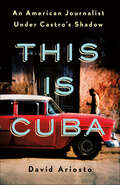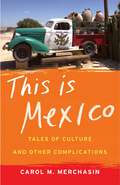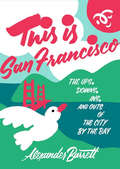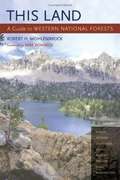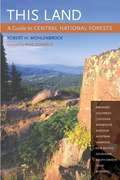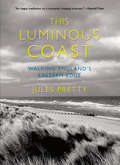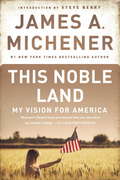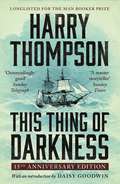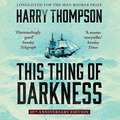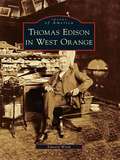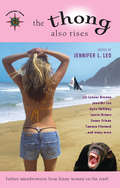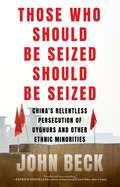- Table View
- List View
This Is Cuba: An American Journalist Under Castro's Shadow
by David AriostoUSA Today "New and Noteworthy" • One of The Washington Post's "10 Books to Read—and Gift—in December""Fascinating." —ForbesFidel Castro is dead. Donald Trump was elected president. And to most outsiders, the fate of Cuba has never seemed more uncertain. Yet those who look close enough may recognize that signs of the next revolution are etched in plain view.This is Cuba is a true story that begins in the summer of 2009 when a young American photo-journalist is offered the chance of a lifetime—a two-year assignment in Havana.For David Ariosto, the island is an intriguing new world, unmoored from the one he left behind. From neighboring military coups, suspected honey traps, salty spooks, and desperate migrants to dissidents, doctors, and Havana’s empty shelves, Ariosto uncovers the island’s subtle absurdities, its Cold War mystique, and the hopes of a people in the throes of transition. Beyond the classic cars, salsa, and cigars lies a country in which black markets are ubiquitous, free speech is restricted, privacy is curtailed, sanctions wreak havoc, and an almost Kafka-esque goo of Soviet-style bureaucracy still slows the gears of an economy desperate to move forward.But life in Cuba is indeed changing, as satellite dishes and internet hotspots dot the landscape and more Americans want in. Still, it’s not so simple. The old sentries on both sides of the Florida Straits remain at their posts, fists clenched and guarding against the specter of a Cold War that never quite ended, despite the death of Fidel and the hand-over of the presidency to a man whose last name isn’t Castro.And now, a crisis is brewing.In This Is Cuba, Ariosto looks at Cuba from the inside-out over the course of nine years, endeavoring to expose clues for what’s in store for the island as it undergoes its biggest change in more than half a century.
This Is Cuba: An Outlaw Culture Survives
by Ben CorbettBeyond the throngs of tourists streaming through Central Havana's broad Prado Avenue, and outside the yoke of Castro's 43-year-old Revolutionary program, there exists a parallel Cuba - a separate evolution of a people struggling to survive. With personal stories that depict a people torn between following the directives of their government and finding a way to better their lot, journalist Ben Corbett gives us the daily life of many considered outlaws by Castro's regime. But are they outlaws or rather ingenious survivors of what many Cubans consider to be a forty-year mistake, a tangle of contradictions that has resulted in a strange hybrid of American-style capitalism and a homegrown black market economy. At a time when Cuba walks precariously on the ledge between socialism and capitalism, This Is Cuba gets to the heart of this so-called outlaw culture, taking readers into the living rooms, rooftops, parks, and city streets to hear stories of frustration, hope, and survival. Updated with a new preface.
This Is Me: A Story of Who We Are and Where We Came From
by Jamie Lee Curtis Laura Cornell<p>From the #1 New York Times bestselling creative team of Jamie Lee Curtis and Laura Cornell comes a timely picture book about immigration. Raising important identity issues like “Where did we come from?” and “Who are we?” This Is Me is as delightful as it is important, sure to stimulate dinner table conversation. <p>In This Is Me a teacher tells her class about her great-grandmother’s dislocating journey from home to a new country with nothing but a small suitcase to bring along. And she asks: What would you pack? What are the things you love best? What says “This is me!” With its lively, rhyming language and endearing illustrations, it’s a book to read again and again, imagining the lives of the different characters, finding new details in the art, thinking about what it would be like to move someplace completely different. </p>
This Is Mexico: Tales of Culture and Other Complications
by Carol M. MerchasinThis Is Mexico is a collection of essays on the often magical and mysterious—and sometimes heartrending—workings of everyday life in Mexico, written from the perspective of an American expatriate. By turns humorous and poignant, Merchasin provides an informed look at Mexican culture and history, exploring everything from healthcare, Mexican-style, to religious rituals; from the educational role of the telenovela to the cultural subtleties of the Spanish language. Written with a clear eye for details, a warm heart for Mexico, and a lively sense of humor, This Is Mexico is an insider's look at the joys, sorrows, and challenges of life in this complex country.
This Is Mexico City
by Abby Clawson LowThis gorgeous travel and look book is a love letter to Mexico City that celebrates in photographs and descriptive text the vibrant cultural, architectural, design, art, and culinary destinations in this extremely popular and trending destination.Vast and exciting, Mexico City has so much to offer for both tourists and locals. This Is Mexico City is a visual and descriptive guide with an emphasis on design, art, architecture, and culture, showcasing the best museums (both traditional and off-the-beaten-path), old-school mercados, public art, locals' favorite restaurants--from the fancy to the food trucks--and more. This lifestyle-driven city tour will captivate Mexico City's residents, future and past visitors, and even armchair travelers enjoying from home everything that this incredible city has to offer.
This Is Not A Drill: Just Another Glorious Day in the Oilfield
by Paul CarterThe outrageous sequel to Don't Tell Mum I Work on the Rigs (She Thinks I m a Piano Player in a Whorehouse) brings more great stories from the far side of civilization - hilarious, full of humour, colourful characters and dramatic action! Just another glorious day in the oilfield for Paul Carter! He s stuck in the middle of the Russian sea on a rig staffed by a crew from Azerbaijan. The choppers are older than him and can only fly by line of sight, turning back regularly due to the weather which gets particuarly interesting when they are past the point of no return with half there fuel gone and they are committed to finding the rig in a fog that s thicker than a Big Brother housemate. The closest thing to a hotel for miles around is the Asylum , a former soviet mental institution that now houses offshore personnel en-route to the rig, where his room mates are Vodka Bob - who drinks Guinness for breakfast when he s not on the rig - Sick Boy, who snores like a pit bull being hot-waxed and Sealbasher . In his inimitable style Paul Carter regales us with his colourful adventures from the front line of thee oil industry and the far side of civilization!
This is Portland: The City You've Heard You Should Like
by Alexander BarrettThis is Portland is a first-hand look at a city that people can't seem to stop talking about. It's a guidebook of sorts, but not to restaurants and sightseeing.<P><P> Instead, Alexander Barrett is your friendly guide to the quirky characters and atmosphere of Portland, Oregon and how fun, beautiful, and ridiculous it can be. With its approachable, often hilarious tone, this book is perfect for anyone who wants to learn more about bikes, beards, beers, rain, and everything else important about the city you've heard you should like.
This is Portland: The City You've Heard You Should Like (People's Guide Ser.)
by Alexander Barrett Andrew DicksonUpdated with a new edition for 2018 and 50% additional material, This is Portland is a first-hand look at a city that people can't seem to stop talking about. It's a guidebook of sorts, but not to restaurants and sightseeing. Instead, Alexander Barrett is your friendly guide to the quirky characters and atmosphere of Portland, Oregon and how fun, beautiful, and ridiculous it can be. With its approachable, often hilarious tone, this book is perfect for anyone who wants to learn more about bikes, beards, beers, rain, and everything else important about the city you've heard you should like.
This is San Francisco: The Ups, Downs, Ins, and Outs of the City by the Bay
by Alexander BarrettIn the same vein as his other two evocative love letters to cities, This Is Portland and This Is Shanghai, Alexander Barrett again plays quirky tour guide in This is San Francisco. Distilling the charm of San Francisco into colorful, illustrated pages, he reveals the city's magic in this good-humored, earnest homage. This isn't a guide book that will tell you where to stay or what to eat; rather, it's an invitation from a friend to come along on a walk down one of San Francisco’s historic streets, up one of its urban staircases, or along its many shorelines. Through thoughtful and funny anecdotes, essays, and illustrations, Barrett takes you on a journey through one of America’s most famous cities and makes you wish you were right there with him.
This Land: A Guide to Western National Forests
by Robert H. MohlenbrockPart armchair travelogue, part guide book, this projected three-volume series--divided into the western, central, and eastern United States--will introduce readers to all 155 national forests across the country. This Land is the only comprehensive field guide that describes the natural features, wildernesses, scenic drives, campgrounds, and hiking trails of our national forests, many of which--while little known and sparsely visited--boast features as spectacular as those found in our national parks and monuments. Each entry includes logistical information about size and location, facilities, attractions, and associated wilderness areas. For about half of the forests, Robert H. Mohlenbrock has provided sidebars on the biological or geological highlights, drawn from the "This Land" column that he has written forNatural Historymagazine since 1984. Superbly illustrated with color photographs, botanical drawings, and maps, this book is loaded with information, clearly written, and easy to use.
This Land: A Guide to Central National Forests
by Robert H. MohlenbrockA comprehensive guide to the facilities and natural features in the 43 national forests in Arkansas, Colorado, Louisiana, Minnesota, Missouri, Montana, Nebraska, New Mexico, Oklahoma, South Dakota, Texas, and Wyoming.
This Land Is Our Land: How We Lost the Right to Roam and How to Take It Back
by Ken IlgunasPrivate property is everywhere. Almost anywhere you walk in the United States, you will spot “No Trespassing” and “Private Property” signs on trees and fence posts. In America, there are more than a billion acres of grassland pasture, cropland, and forest, and miles and miles of coastlines that are mostly closed off to the public. Meanwhile, America’s public lands are threatened by extremist groups and right-wing think tanks who call for our public lands to be sold to the highest bidder and closed off to everyone else. If these groups get their way, public property may become private, precious green spaces may be developed, and the common good may be sacrificed for the benefit of the wealthy few.Ken Ilgunas, lifelong traveler, hitchhiker, and roamer, takes readers back to the nineteenth century, when Americans were allowed to journey undisturbed across the country. Today, though, America finds itself as an outlier in the Western world as a number of European countries have created sophisticated legal systems that protect landowners and give citizens generous roaming rights to their countries' green spaces. Inspired by the United States' history of roaming, and taking guidance from present-day Europe, Ilgunas calls into question our entrenched understanding of private property and provocatively proposes something unheard of: opening up American private property for public recreation. He imagines a future in which folks everywhere will have the right to walk safely, explore freely, and roam boldly—from California to the New York island, from the Redwood Forest to the Gulf Stream waters.
This Luminous Coast: Walking England’s Eastern Edge
by Jules PrettyOver the course of a year, Jules Pretty walked along the shoreline of East Anglia in southeastern England, eventually exploring four hundred miles on foot (and another hundred miles by boat). It is a coast and a culture that is about to be lost—not yet, perhaps, but soon—to rising tides and industrial sprawl. This Luminous Coast takes the reader with him on his journey over land and water; over sea walls of dried grass, beside stretched fields of golden crops, alongside white sails gliding across the intricate lacework of invisible creeks and estuaries, under vast skies that are home to curlews and redshanks and the outpourings of skylarks. East Anglia's coastline is as much a human landscape as it is a natural one, and Pretty is equally perceptive about the region's cultural heritage and its "industrial wild": fishing villages and the modern seaside resorts, family farms and oil refineries, pleasure piers and concrete seawalls, cozy pubs and military installations. Through words and photographs, Pretty interweaves stories of the land and sea with people past and present. He is a passionate and sensitive guide to a region in transition, under stress, and perhaps even doomed, as finely attuned to its history as he is to its unique sensory world.
This Noble Land
by James A. MichenerIn such modern classics as Chesapeake, Centennial, Hawaii, Alaska, and Texas, James A. Michener proved time and again that his understanding of and love for his country was unparalleled. This Noble Land is Michener's most personal statement about America, an examination of the issues that threaten to fragment and undermine the nation--racial conflict, the widening gulf between rich and poor, the decline of education, the inadequacies of our health care system--as well as a thought-provoking prescription for sustaining our "outstanding success." First published shortly before Michener's death, This Noble Land stands as a wake-up call for a troubled era, infused with the wisdom and passion of a lifetime. Praise for This Noble Land "A book-length essay on the often worrying, often inspiring course of America in the nine decades of Michener's life."--The Washington Post "Michener is more interested in fixing the problems than in fixing the blame."--The Dallas Morning News "Michener's are the beach books that, unlike most other beach books, leave you smarter than you were when you started reading. Each delivers the product of all that research, doled out to the reader at just the right rate. You know right away who the bad guys are--the petty ones, the stingy ones. The heroes are generous and energetic and smart and, above all, unprejudiced. The real-life villains in This Noble Land are the people Michener perceives as 'petty, mean and vengeful.'"--St. Louis Post-Dispatch "Stirring . . . an admirable effort to define what has made our country great and how to preserve what is best about it."--Kirkus ReviewsFrom the Trade Paperback edition.
This Story Is for You (Hyperion Picture Book (eBook))
by Greg PizzoliA simple "It's nice to know you" holds so much power in this tender picturebook by acclaimed author-illustrator Greg Pizzoli. Finding value in others as a matter of course, the narrator accepts and appreciates difference as the foundation of a life-long friendship. This Story Is for You celebrates moments of kindness throughout, from the small to the grand in a heartwarming tale of human connection.The warm, comforting text shares the tone of a Ruth Krauss classic and is balanced by Greg's energetic color palette and signature visual humor. This book is sure to be a special read for parents, children, and their friends for years to come.
This Thing Of Darkness
by Harry ThompsonA brilliant, action-packed and gripping novel of Charles Darwin's voyage on the Beagle - longlisted for the Man Booker Prize. In 1831 Charles Darwin set off in HMS Beagle under the command of Captain Robert Fitzroy on a voyage that would change the world. 'An outstandingly good first novel. A page-turning action-adventure combined with subtle intellectual arguments. The meticulous research enriches this fascinating tale' Sunday Telegraph 'A master storyteller' Sunday TimesBrilliant young naval officer Robert FitzRoy is given the captaincy of HMS Beagle, surveying the wilds of Tierra del Fuego. He's a man of tradition and principle, with a firm belief in the sanctity of the individual in a world created by God. On board, is a passenger, Charles Darwin - a young trainee cleric, and amateur geologist. This is the story of a deep friendship between two men, and the twin obsessions that tear them apart, leading one to triumph, and the other to disaster.
This Thing Of Darkness
by Harry ThompsonThe 15th anniversary edition of a brilliant, action-packed and gripping novel of Charles Darwin's voyage on the Beagle - longlisted for the Man Booker Prize. New introduction from Daisy Goodwin.'A master storyteller' Sunday TimesIn 1831 Charles Darwin set off in HMS Beagle under the command of Captain Robert Fitzroy on a voyage that would change the world. This is the story of a deep friendship between two men, and the twin obsessions that tear them apart, leading one to triumph, and the other to disaster.'An outstandingly good first novel. A page-turning action-adventure combined with subtle intellectual arguments. The meticulous research enriches this fascinating tale' Sunday Telegraph
This Thing Of Darkness
by Harry ThompsonColin Morgan narrates the action-packed and gripping novel of Charles Darwin's voyage on the Beagle - longlisted for the Man Booker Prize. 'A masterpiece' Bernard Cornwell'A master storyteller' Sunday TimesIn 1831 Charles Darwin set off in HMS Beagle under the command of Captain Robert Fitzroy on a voyage that would change the world. This is the story of a deep friendship between two men, and the twin obsessions that tear them apart, leading one to triumph, and the other to disaster.'An outstandingly good first novel. A[n]... action-adventure combined with subtle intellectual arguments. The meticulous research enriches this fascinating tale' Sunday Telegraph (P) 2021 Headline Publishing Group Ltd
Thomas Edison in West Orange
by Edward WirthThomas Edison spent the second half of his life in West Orange, about 10 miles from New York City. There he built his last and largest laboratory, where he developed motion pictures, improved the phonograph, and built an international business empire, earning over half of his 1,093 patents. The five laboratory buildings housed over 100 experimenters busily engaged in invention and innovation. As they turned ideas into commercial products, Edison surrounded the laboratory with factories that employed over 4,000 workers. From the first days, staff photographers documented every aspect of life in this town within a town.
Thomas Jefferson Travels: Selected Writings, 1784-1789
by Anthony BrandtBrandt (editor, National Geographic books) explores a little-known aspect of Jefferson's body of work, using excerpts from Jefferson's voluminous travel diaries and personal correspondence to follow his journeys throughout Europe during his five-year residency in Paris. The writings give readers a new perspective on European life in the 18th century and on the beginnings of the French Revolution. Brandt provides an introduction and commentary throughout the selections. Annotation ©2006 Book News, Inc. , Portland, OR (booknews. com)
Thomaston (Images of America)
by Joseph F. Wassong Jr.Thomaston, a gateway to the Litchfield Hills and the Berkshires, is situated in the picturesque Naugauck River Valley. This town of Victorian charm grew as local industry developed. Today, it includes a population representing many occupations and nationalities and a mixture of urban and suburban culture. Thomaston reveals the history of this town and its people, including a nineteenth-century priest who is a candidate for sainthood in the Roman Catholic Church, the grandfather of a Nobel Prize-winning author, and a hero who was awarded the Medal of Honor for valor at Pearl Harbor. The first part of the book is designed as a guide for a walking tour of the downtown area.
The Thong Also Rises
by Jennifer L. LeoToo many travel guides are dry lists of attractions or portentous histories of a place. This isn't the case with The Thong Also Rises. Hot on the (high) heels of Sand in My Bra and Whose Panties Are These? comes this collection of the best in women's travel and humor writing. These Ms-adventures take readers around the world and back again - and they'll be happy to be reading rather than experiencing some of these adventures. Subjects include learning how to go to the bathroom with a pig in Thailand, trying to explain that sex toy to customs while Mother is watching, attending naked wedding ceremonies on Valentine's Day in Jamaica, conquering that consuming fear of wooden puppets with a visit to Prague, boarding a crusty old Soviet Bomber in Laos, and more.
Thor Heyerdahl, Viking Scientist
by Wyatt BlassingameMeet Thor Heyerdahl! As a young boy, he could not learn to swim. As a high school student, he opened a museum. As a man, he sailed Balsa wood and papyrus reed boats. He became a respected scientist, and a protector of oceans.
Thoreau's Walden
by Tim SmithWalden Pond is a sublime place of peace and spirituality. Writer and philosopher Henry David Thoreau built a one-room house in 1845 and lived on the shores of the pond for two years, two months, and two days. It is this "experiment in independent living" that draws millions of people to visit the pond and to pay homage to the man sometimes called the father of American conservation. Situated in woodland outside the town of Concord, the pond and the town itself also evoke history on a grand scale. The Revolutionary War and the literary revolution of the mid-nineteenth century both began in the area.Thoreau's Walden describes the beauty of this historical setting through the writings of Thoreau. The book uses many of his most captivating and inspiring quotations as a tribute to the man and his life, works, and philosophy. Beautiful images and descriptive historical writing combine to create a visual insight into the reasons why Thoreau lived at Walden and what he has to teach us about this most inspirational place. Thoreau's Walden also includes little-known facts about the writer and philosopher, including the stories behind his relationship with Ralph Waldo Emerson, his search for the perfect location for his experiment, and his many visitors, such as Nathaniel Hawthorne and the Alcott family.
Those Who Should Be Seized Should Be Seized: China's Relentless Persecution of Uyghurs and Other Ethnic Minorities
by John BeckA shocking, on-the-ground investigation of the Chinese government&’s brutal oppression of its Muslim citizens — the Uyghurs, ethnic Kazakhs, and others — from Xinjiang to the streets of New York and Washington, DC . . .Award-winning journalist John Beck recounts China's persecution of the predominantly Muslim minorities in Xinjiang and its relentless pursuit of the few who escaped beyond its borders. Through intertwined literary narratives combined with snippets of original source material, including official directives and speeches, he pieces together the individual stories of what consecutive American administrations have described as genocide. The narrative moves from China to Kazakhstan, Turkey and the US, incorporating the tensions, discrimination, and occasional violence that characterised life in Xinjiang for decades. But when Xi Jinping is appointed President in 2013, the creeping repression quickly escalates into a crackdown of unprecedented scope and severity.Beck follows 4 characters: a Kazakh writer and an Uyghur nurse who survived re-education camps before ultimately escaping abroad, a human rights advocate involved in securing their release, and an inadvertent exile spied on by Chinese authorities as his family back home was used as leverage against him.Through their stories, the book explores identity, dehumanization, and censorship, the force of literature in dark times, and an all-pervasive apparatus of repression able to exist within miles of the White House.John Beck lived in Istanbul for a number of years, where he was in close contact with the city's Uyghur diaspora and wrote on the crackdown and related issues for publications including Harper's and National Geographic. Some of that work forms the basis of this book along with further reporting from Almaty, Kazakhstan, Virginia, and New York.
